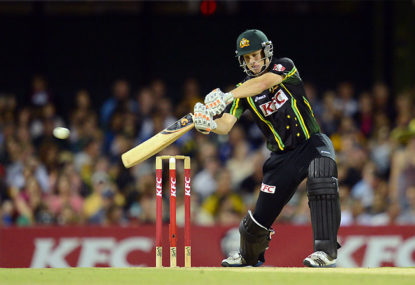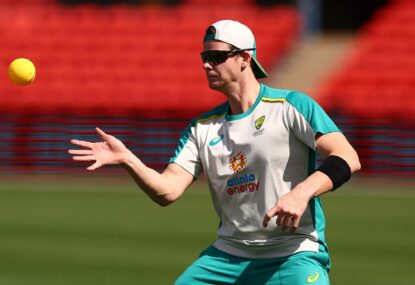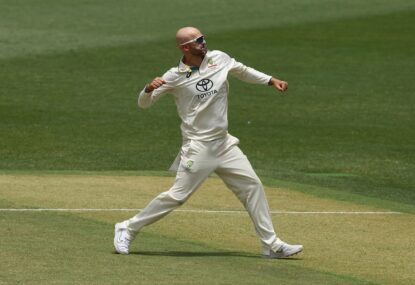With all the electrifying action in the World Cup, you could be forgiven for not noticing that the Sheffield Shield season came to a tame close on Wednesday afternoon.
Victoria pipped Western Australia in a game of attrition, holding out for a draw to win the championship for the first time since 2009-10, and denying Western Australia a clean sweep of all the domestic trophies for season 2014-15 in the process.
Ignoring for the moment the disappointment of seeing a final played on such an unsporting and lifeless pitch, tailor-made for obdurate and frankly mind-numbing innings such as Matthew Wade’s unbeaten nine off 99, the season has propelled a few newcomers and other more familiar faces into consideration for the upcoming Test tours to the West Indies and England.
The season has been a promising one for Australian cricket, with the simultaneous rise of some experienced batsmen, exciting spin bowlers and a successful summer for the national side boding well for the winter tours and beyond.
From a batting perspective, the season was overwhelmingly dominated by experienced, mature-aged batsmen. Thirty-five-year-old Adam Voges raced into calculations for the unsettled middle order with a prolific season for the West Australians; he scored 1358 runs at an average of 104.5 and six centuries, including a majestic 249 against South Australia.
Having been previously capped 31 times for Australia at ODI level (and having the impressive average of 45.78 over those matches), Voges appears to be the level head perfect for the middle order, particularly given Steven Smith’s expected elevation to number three and Shane Watson’s demotion to six.
Add to that his leadership capacities as captain of his state and his experience of English conditions from his time at Nottinghamshire, Hampshire and Middlesex, and he seems to fit the exact mould of a toughened and hard-working batsman that prompted the selectors to choose Chris Rogers for the last tour of England. Age is obviously a factor against his selection, but the current selection panel have made it clear that weight of runs precedes age, and would do well to reward Voges for an outstanding season.
And something about the idea of Voges playing late, negating swing and steadying the ship at number five is just much more attractive than someone like Glenn Maxwell or Mitch Marsh doing so – at least for now.
Further mention must be made of another old-timer, Michael Klinger, whose move westward after many successful seasons in Adelaide reaped considerable reward. His 1046-run season after years of solid run scoring is testament to his consistency and durability. His chances of selection in the Australian squad seem remote at first glance, with younger names such as Joe Burns earmarked for a top order spot in years to come and with Steve Smith looking like the mainstay at three for the next decade.
However, with the lack of a clear frontrunner to replace Chris Rogers come August, it would not be completely shocking to see Klinger seriously considered. Other names near the top of the run-scoring charts include Callum Ferguson (fourth with 836 runs and four centuries) and Ed Cowan (fifth with 815 runs and four centuries). Both have been consistent for a few seasons, but their chances of selection are low.
Ferguson probably still has Voges, Shaun Marsh and Burns ahead of him in calculations for a middle-order spot, and Cowan’s immediate future is clouded after his decision to move back to Sydney for family reasons. In any case, Cowan’s last foray into Test cricket revealed his limited scoring range and struggle to keep a good tempo in his innings, and Ferguson seems to have just missed his chance for good after an untimely knee injury in 2009.
One exception to the trend of older batsmen compiling more runs is Cameron Bancroft. The 22-year-old finished third on the list with 896 runs, behind his West Australian teammates Voges and Klinger, and his ability to bat long (seen in his maiden double century a few weeks ago) puts him in the frame for the opening spot post-Rogers.
His ascension is particularly timely given the lack of other in-form opening options in the country. Jordan Silk lost form dramatically after a prolific first season, Cowan’s future is uncertain and players like Nic Maddinson have a little more development to undergo. Although a spot in the Ashes squad this year would be highly surprising, expect to see his name in Australian squads in the years to come (provided he can back this season’s exploits up).
Despite not scoring as heavily, other young names to keep in mind for the seasons to come are Peter Handscomb and Travis Head, both of whom are extremely talented and future (or current, in Head’s case) leaders of their states. And sure, many of the players listed above would struggle with a moving ball on a juicy green-top, but in an increasingly batting-friendly world (with huge bats, small grounds and generally flat pitches) and as part of a strong team, they would likely flourish in the same vein as Stiaan van Zyl and Temba Bavuma have for South Africa.
To the bowlers now, and it is immediately obvious that a new candidate to rival Nathan Lyon has definitively emerged in Fawad Ahmed. He took 48 wickets at 24.85 during the season, including a wonderful 8-89 in the first innings of the final, and looks to have the control, guile and sharp turn lacking from any Australian wrist spinner since Shane Warne.
One would expect that he will partner Lyon in a two-pace, two-spin attack in the West Indies, and then shadow Lyon for the Ashes, with a view to challenging him for the main spot in the years to come. Fawad is only 33, and looks to have at least three years at the top level, during which he could become very valuable to Australian cricket.
Ashton Agar’s successful season is likely to foment excitement in all Australians who remember his extraordinary innings at Trent Bridge not two years ago. One of only two bowlers to take a ten-wicket haul this season (the other being Jason Behrendorff), his improved control and variation is a welcome development for a potential spin-bowlng number seven in the Australian team one day. For the Windies and Ashes tours, however, it is unlikely that he will make the cut, with Fawad ahead of him as the spinner and Maxwell and M. Marsh shoe-ins for the all-rounders’ spots.
In the pace bowling stocks, Andrew Fekete (37 wickets) and Nathan Rimmington (35) proved consistent, but lack the x-factor and athletic ability that seem to be prerequisites for selection as a fast bowler these days. Peter Siddle bowled impressively in his seven matches picking up 28 wickets at 20, but with such a long line of bowlers ahead of him (Mitchell Johnson, Ryan Harris, James Pattinson, Josh Hazlewood, Mitchell Starc, Pat Cummins and now players like Jason Behrendorff and Gurinder Sandhu), he will rely on injuries to get him back into the team.
It is worth keeping your eyes on Behrendorff and Chadd Sayers, both of whom missed the second half of the season with stress fractures. Their solid performances over a number of years, and Behrendorff’s promise in shorter formats too, make them valuable squad options for the selectors.
On a side note, the tussle for the wicket-keeping spot behind Haddin shapes as a three-horse race between Matthew Wade, Peter Nevill and Sam Whiteman. The first two had very similar batting seasons and are experienced campaigners, which might see them pip Whiteman’s untapped talent, but further than that it seems impossible to decide.
The squad for the West Indies tour is likely going to be very similar to the one that tackled India in the home summer, given their success. A conservative guess would be that it will read something like this: Rogers, Warner, Smith, Clarke, Voges, Watson, Haddin, Johnson, Harris, Lyon, Fawad, M Marsh, Hazlewood, Starc, Burns, Maxwell.
Perhaps they will play Maxwell for Fawad and Marsh for Watson, or perhaps Burns will retain his spot over Voges, or Shaun Marsh, for whom selectors seem to bear an indelible love. But in any case, a high-quality season of Sheffield Shield cricket has left the Australian selectors with the best kind of headache, and left fans anticipating years of Australian primacy.






































































































